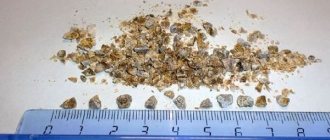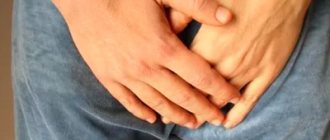In principle, two forms of urinary incontinence can be distinguished: stress urinary incontinence or stress urinary incontinence and urge urinary incontinence. The most common type of incontinence is stress incontinence, when urine loss occurs during physical activity (coughing, sneezing, running, jumping, lifting heavy objects, etc.).
Unfortunately, this disease affects women of all age groups. Moreover, up to 50% of women suffer from urinary incontinence during pregnancy, and a third of them continue to experience symptoms of the disease after childbirth. Urgent incontinence is a type of incontinence in which loss of urine occurs against the background of a strong urge to go to the toilet or when thinking about the toilet, or against the background of provoking factors (the sound of running water, the proximity of a toilet or home, stress).
Cystitis and sex
If you had prolonged or too intense sexual contact, then after it you may experience a frequent urge to urinate and pain during it; these symptoms do not always indicate an infection. They often arise due to the fact that the bladder, and in particular the neck and urethra, become “irritated” due to mechanical stress.
If these symptoms do not subside within 24 hours, then you should collect a urine test, an average sample, and contact a specialized doctor for cystitis (urogynecologist, gynecologist, urologist) as a matter of urgency.
Cystitis at any age
An acute attack of cystitis after sexual intercourse can occur at any age. Decades ago, when women maintained their virginity until marriage, cystitis that occurred after sexual intercourse was called the “honeymoon disease.”
At the present time, the fact is that no matter what your age, if the contact took place after a long break, the meeting was too active or sex happened with a new partner, you are not immune from the development of acute cystitis.
Preventive measures recommended by doctors
Once cured, do not forget about prevention to prevent the recurrence of unpleasant symptoms. Basic measures:
- Empty your bladder regularly, do not wait too long;
- avoid hypothermia;
- quit smoking;
- increase the amount of vegetables and fruits in the diet;
- drink about 1.5 liters of water per day;
- change underwear daily, avoid synthetics;
- If you have a sedentary job, do a warm-up every hour;
- strengthen immunity;
- do gymnastics, including Kegel exercises.
The disease is easier to prevent, so the listed preventive measures should be remembered and strictly followed. If unpleasant symptoms appear, consult a doctor immediately!
Causes of cystitis after sex
The main cause of inflammation of the bladder after sexual intercourse is a bacterial infection - the entry of pathogenic microorganisms into the female bladder.
Inflammation of the urinary tract after sexual intercourse can occur for several reasons, mainly anomalies of physiological development. In some women, the external opening of the urethra is located close to the opening of the vagina and bacteria easily enter the bladder.
Another cause of cystitis may be poor personal hygiene, both by women and men. Dirt and bacteria from the hands or genitals can enter the urinary system and cause inflammation.
In addition, the cause of the disease may be a combination of anal and vaginal sex in one sexual act. Among the bacteria that cause cystitis is E. coli, which, when it enters the urinary system, causes extremely unpleasant consequences. Up to 90% of cystitis is caused by the bacterium Escherichia coli, and movement during sex helps move this bacterium into the urethra and bladder.
Cystitis after sex can also develop due to sexually transmitted diseases, microflora disturbances in the vagina, and as a result, with inflammatory phenomena in the pelvic organs.
Any damage to the mucous membrane of the urethra during sexual activity gives rise to excessive proliferation of pathogenic microflora and the development of inflammatory processes. This is especially true if a woman has not had sex for a long time, sexual intercourse was prolonged and/or the woman’s vagina is poorly moisturized (dry, due to the lack of a sufficient amount of “natural” mucus).
Some women also find that certain sexual positions cause irritation and cystitis. Sex from behind, for example, is especially harmful for women who are prone to cystitis.
Cystitis in elderly women: treatment and prevention of the disease
Causes of cystitis in older women
The cause of cystitis in women over 40 years of age is a decrease in the immunity of the genitourinary system. This situation occurs due to a reduction in the production of hormones, resulting in a decrease in the production of collagen, which maintains the elasticity of the lining of the bladder. Because of this, the organ becomes vulnerable to the aggressive effects of urine and pathogenic microflora. [27] The following factors usually contribute to the occurrence of urinary tract infections [28]:
- failure of the epithelium of the urinary tract;
- reduction of urothelial mucus formation;
- pelvic organ prolapse;
- microcirculation disturbance;
- frequent hypothermia;
- physical inactivity;
- urolithiasis disease;
- abuse of drugs that change the microflora of the pelvic organs.
Bladder inflammation often occurs due to increased contamination in the urethral area, which is facilitated by urinary and fecal incontinence and poor hygiene. Most often in old age, cystitis develops due to E. coli. In some cases, the causative agents of the inflammatory process can be ureaplasma, enterococci, staphylococci, and chlamydia. [27]
It is noteworthy that 20% of patients have microbial associations, and the dominant bacteria may change. This situation is especially dangerous for elderly patients who prefer to self-medicate. In this case, there is a risk of chronic inflammation, and with chronic cystitis in older women, treatment will take longer. [27]
Often the cause of cystitis during menopause is a tendency to constipation. A crowded intestine puts pressure on the walls of the bladder, which leads to disruption of microcirculation and a change in its location. Untimely and incomplete emptying of the bladder leads to the accumulation of toxic fluid, which gradually corrodes its inner surface. This is exactly how, without the participation of infectious agents, some patients develop interstitial cystitis. [28]
Symptoms of cystitis in older women
The symptoms of the disease in old age are the same as in young patients. Typical signs of cystitis are [16, 27]:
- frequent urge to empty the bladder during the day and night;
- the appearance of minor spots of blood in the urine;
- nagging pain in the lower abdomen;
- atypical discharge from the urethra;
- increase in body temperature to 37.2°C.
The appearance of itching and burning in the perineum and pubic area is also one of the signs of an uncomplicated urinary tract infection. If one of the listed signs appears, it is necessary to undergo a full examination in order to make an accurate diagnosis and select drugs for the treatment of cystitis. The fact is that many diseases of the genitourinary system have symptoms similar to cystitis and treatment, if carried out incorrectly, there is a high risk of inflammation becoming chronic. [16]
How to prevent the development of cystitis?
Preventive measures do not guarantee the absence of relapses. But if you follow some simple recommendations, elderly patients can improve their quality of life and prolong the period of remission. [29]
With the onset of menopause, women should pay special attention to the health of the genitourinary system. First of all, you need to undergo an examination by a gynecologist. Your doctor will order the necessary tests to determine your estrogen levels. If necessary, the gynecologist will select medications to maintain normal hormonal levels, strengthen the barrier membranes of the bladder, and strengthen the immune system. [29]
As part of the prevention of the development of cystitis in older women, special attention should also be paid to personal hygiene. In older women, cystitis is often accompanied by urinary incontinence (especially after the age of 80), which occurs due to prolapse of the pelvic organs. In this situation, one of the effective ways to prevent the development of urinary tract inflammation is to maintain personal hygiene. [29]
In old age, in order to prevent the development of urinary tract infections, it is also necessary to adjust the diet. The daily menu should include protein foods, vegetable fats, slow carbohydrates, minerals, and vitamins. But at the same time, salty, spicy, too fatty and fried foods should be excluded. Proper nutrition will help create an environment in the bladder that has high immune capacity. [29]
With age, many women are prone to physical inactivity, which does not have the best effect on the health of the genitourinary system. To strengthen the immune system, improve metabolic processes and the general condition of the body, daily muscle activity is needed. [29]
Treatment of cystitis in women should be prescribed by a doctor. Regular visits to a urologist, therapist, or gynecologist will help to detect the problem in a timely manner and select the necessary therapy. [29]
The drug Fitolysin® in the treatment of cystitis in women
Herbal medicines are often involved in the complex treatment of uncomplicated urinary tract infections. One of them is the diuretic Phytolysin®. It is available in the form of a paste for oral suspension. In this form, the active components are better absorbed and delivered directly to the site of inflammation. [2, 26]
This medicine for cystitis contains extracts of goldenrod, horsetail, knotweed, birch leaves, onion peels, as well as sage and mint oils, and other plant components [6, 26]. The natural diuretic Phytolysin® has several advantages:
- convenient and effective form of release [2];
- diuretic, anti-inflammatory, antispasmodic effects [6].
Fitolysin® paste is prescribed as part of complex therapy for cystitis. It helps eliminate urinary disorders, fight spasms and pain, and stop the inflammatory process [1]. The production of the drug complies with GMP standards. [3]
The first signs of cystitis after sex
Cystitis after sex has several differences from acute cystitis. First of all, symptoms of the disease occur either in the first few hours or 1-2 days after intimacy.
The first symptoms are a frequent urge to urinate, which is accompanied by pain, burning, stinging, a feeling of incomplete emptying of the bladder, urine changes color and smell, and becomes cloudy. Body temperature may rise to subfebrile levels, pain or discomfort may appear in the lower abdomen and lumbar region. Some symptoms may be less severe or not appear at all.
Make an appointment
Make an appointment with a gynecologist by calling 8(812)952-99-95 or filling out the online form - the administrator will contact you to confirm your appointment
guarantees complete confidentiality
Diagnostics
Diagnosing urinary incontinence is not as simple as it may seem. Unfortunately, the patient only sees the result - loss of urine, and its causes can be very different. The main diagnostic role in this disease belongs to interviewing the patient. It is assessed under what circumstances and how long ago urine loss occurs. Next, find out the number of pads or diapers used.
Based on this indicator, we can draw a conclusion about the severity of the disease: 1-2 pads - light, and if more than 5, then severe. If the patient loses urine at night, against the background of a strong urge to go to the toilet or thoughts about it, it is more likely to say that this is urge urinary incontinence. In a situation where urine loss occurs during physical activity, the patient most likely suffers from stress incontinence. Unfortunately, patients often note a combination of factors. Then we are dealing with a mixed form of urinary incontinence.
An important element of diagnosis is a gynecological examination, during which, in addition to standard procedures, special tests are performed. First of all, this is a stress test in which the patient with a full bladder is asked to cough or strain hard. If there is loss of urine during the test, this indicates stress incontinence. In complex cases, a special comprehensive urodynamic study is necessary.
Complications and consequences of postcoital cystitis
Cystitis after sex is dangerous due to its complications, like any other inflammation.
If you ignore the first signs, the disease may develop into a more severe form that is more difficult to treat. Infection from the bladder can spread higher and provoke inflammatory kidney disease - pyelonephritis. In addition, if cystitis after sex occurs every time, a woman will eventually lose the desire to have sexual intercourse due to the fear of getting cystitis again, and this in turn leads to uncertainty, stress, disagreements between partners, etc.
Recently, self-medication has become widespread, and women who already know their problem can take a course of antibiotics immediately after sexual intercourse, but regular use of such drugs can cause other, more serious problems (in particular, uncontrolled use leads to drug resistance, i.e. e. antibiotics become powerless in the fight against pathogenic microorganisms).
In addition, antibiotic treatment is contraindicated during pregnancy, and cystitis in this situation can lead to miscarriage, premature birth, and cessation of fetal development. All experts agree that cystitis requires professional and complete treatment, otherwise not only physical problems are possible, but also psychological ones, both on the part of the woman and the family as a whole.
In response to inflammation, an admixture of blood may appear in the urine - hemorrhagic cystitis, and frequent episodes of inflammation lead to a chronic process with the involvement of deeper layers of the bladder wall in the inflammatory process, partial or complete destruction of the GAG layer (glycosaminoglycan layer) - a protective or barrier layer , which prevents the adhesion of bacteria to the bladder mucosa.
Treatment
Treatment of urinary incontinence in women is entirely determined by its type. For urgent urinary incontinence, the main treatment method is conservative therapy aimed at reducing the number and intensity of the urge to urinate. In the case of stress urinary incontinence, all treatment methods aim to restore the continence mechanism. The first step in combating stress urinary incontinence is normalizing weight, quitting smoking, and combating chronic cough and constipation.
With mild degrees of incontinence and in patients after childbirth, training the pelvic floor muscles gives good results. Kegel exercises are especially effective when performed under the supervision of a physical rehabilitation specialist or with the help of special biofeedback devices (BFB therapy). In this case, the patient feels the pelvic floor muscles better and understands how and what to train.
Unfortunately, exercises do not always help, and even patients seek help with advanced stages of the disease. In such a situation, the only effective method is surgical treatment. The recognized standard in this area is sling surgery, which involves installing special narrow tapes/prostheses under the urethra, which restores urinary continence.
The most difficult issue is fine-tuning the tension of the prosthesis. To solve this problem, adjustable slings were developed, which allow the operation to be strictly individualized for each individual patient.
Tests for diagnosing cystitis
If a urogynecologist diagnoses “postcoital cystitis” (or cystitis after sex), to confirm it, not only anamnesis and examination of the patient is required, but also additional examination.
First of all, analyzes are carried out:
- general blood test (the basis for diagnosing most diseases),
- general urinalysis (study of the chemical and physical properties of urine, which may indicate pathological processes in the body),
- urine culture - bacteriological examination (detects infection in the urinary tract and its sensitivity to antibiotics),
- vaginal smear (allows you to identify pathogenic bacteria and identify the inflammatory process).
Cystitis tablets for women: natural antibiotics
The main drugs for the treatment of cystitis are antibiotics. These are medications of natural composition or synthetic compounds that destroy harmful microorganisms. Natural antibiotics include:
- penicillins;
- cephalosporins;
- phosphonic acid based products.
Penicillin and drugs based on it destroy the enzymes of bacteria and fungi, which leads to their death. To increase the therapeutic effect, penicillin is combined with cavulanic acid, which protects the active substance from premature destruction. Examples of a drug based on these compounds are Augmentin (Amoxilav). Dispensed upon presentation of a prescription, retail price 150 rubles per package of 20 pcs.
Drugs of the cephalosporin group are intended for the treatment of cystitis in advanced and uncomplicated forms in both women and men. Inexpensive effective antibiotics of this group:
- "Suprax";
- "Cedex";
- "Cefotaxime";
- "Cefoperazone" and others.
Also, the natural antibiotic “Monural”, the active ingredient of which is fosfomycin (based on phosphonic acid), is very helpful in the treatment of cystitis. The compound destroys the cell walls of pathogenic microorganisms, the therapeutic effect is noticeable already in the first day. Sold upon presentation of a prescription at a price of 450 rubles per package of 2 granules for preparing a solution.
Instrumental diagnosis of cystitis
Instrumental diagnostics, as the name suggests, is carried out using instruments. Cystitis after sex can be confirmed in the following ways:
- Kidney ultrasound
- Ultrasound of the bladder
- Ultrasound of the pelvic organs
- Cystoscopy of the bladder in women
Ultrasound examination to detect signs of inflammation in the bladder and kidneys, uterus and its appendages.
Cystoscopy is an examination of the urinary tract using a special optical system to determine the volume and depth of damage to the bladder mucosa. (more details...)
Symptoms
The manifestation of urinary incontinence is always the same as the name implies - loss of urine under various circumstances. Depending on the severity of symptoms, the amount of urine lost can vary widely from episodic loss in single drops to total incontinence, when it does not last at all. Also, urine can be lost at different times (night and/or daytime). As mentioned above, incontinence can be caused by many factors.
| anonymously to the doctor, through the feedback form, we will try to help you. | Ask a Question |
Differential diagnosis of cystitis
Differential diagnosis consists of excluding diseases that are characterized by similar symptoms.
For example, if there are signs of cystitis (painful and frequent urination, changes in urine composition, etc.) and high fever, then this condition may be caused by inflammation of the renal pelvis, not the bladder, and the presence of blood or pus in the urine may be caused by the presence of stones in the urinary tract.
If cystitis after sex bothers you for a long time and is difficult to treat, you should undergo a full examination; perhaps the reasons lie in the presence of other diseases - for example, an active viral infection, sexually transmitted diseases, etc.
Signs of cystitis that are not confirmed by the presence of bacteria in the urine may be associated with a fairly common female disease - cystalgia. The disease occurs exclusively among the female population, characterized by frequent and painful urination and pain in the lower abdomen. Cystalgia has not been fully studied, but, according to some data, it is associated with hormonal disorders and circulatory disorders due to pathological processes in the pelvic organs.
When making a diagnosis, the urogynecologist relies on the patient’s complaints and the results of the examination.
Cystitis in men
Having a long and curved urethra in men significantly reduces the risk of infection entering the bladder. The likelihood of developing cystitis in men under 40-50 who observe personal hygiene rules is extremely low. After overcoming this age limit, in the presence of concomitant diseases, cystitis is diagnosed much more often.
“Provocateur” diseases include prostatitis, prostate adenoma, vesiculitis, urethritis, prostate cancer, etc. They are usually accompanied by a narrowing of the urethra. As a result, the bladder does not empty completely. Stagnant urine is formed, which serves as a favorable environment for the development of pathogenic microorganisms - the causative agents of cystitis.
The disease in men occurs in a more severe form and is accompanied by an increase in temperature and general intoxication of the body, since cystitis in men develops as complications of other diseases. The chronic form of the disease in men occurs with virtually no symptoms.
Treatment of cystitis after sex
Treatment is both symptomatic and etiotropic in nature (i.e., eliminating the cause of the disease).
For example, the presence of inflammation in the vagina is eliminated with the help of local antifungal and antibacterial drugs. If a sexually transmitted disease is detected, a specialist requires treatment of both partners. If there are anatomical features of the urinary system, the urogynecologist may recommend surgical treatment - urethral transfer, i.e. transposition of the urethra (higher above the vagina), if necessary, the surgeon excises the remains of the hymen, which “stretch” the urethra.
After surgery, recovery takes 7-15 days; in 85% of cases, the operation allows you to forget forever what cystitis after sex is.
Medications
The main treatment for postcoital cystitis is primarily aimed at blocking the spread of infection. Antibacterial therapy helps with this.
The main treatment of cystitis is supplemented with medications that help reduce the unpleasant manifestations of the disease and normalize the functioning of the urinary system - painkillers, herbal medicines, immunostimulants, vitamin complexes.
In the treatment of inflammatory processes in the bladder, the administration of anti-inflammatory drugs through the urethra into the bladder (instillation) is often used.
Cystitis after sex with proper treatment and following all the doctor’s recommendations goes away within a week, but immunostimulating drugs, herbal medicines and vitamins should be taken longer (2-3 weeks).
With this disease, it is extremely important to complete the full course of therapy, otherwise cystitis will become chronic, and treatment of chronic pathology will be much more difficult.
Relieving pain from cystitis
Cystitis is accompanied by a number of unpleasant symptoms, including pain: it bothers you both at rest and often when urinating. Constant pain discomfort leads to partial loss of ability to work and deterioration of well-being. How to relieve pain from cystitis, what is the best way to relieve pain from cystitis in women, and what therapeutic measures can be carried out without the risk of harm to health? We will answer these questions in as much detail as possible.
The following measures will help relieve the pain of cystitis at home:
- Proper nutrition and optimal drinking regimen. Drinking warm drinks, regular tea and compote, and still water helps reduce the unpleasant symptoms of cystitis. You should avoid eating hot, spicy, smoked foods and give preference to vegetables and lactic acid products.
- Thermal procedures. Perhaps this is the most famous and common method of treating cystitis at home. For this procedure, heating pads or ordinary plastic bottles with water can be used. The heating pad is placed between the legs and warms up until it cools down. Despite the fact that this method has been used for quite a long time, it is not suitable for everyone, since contraindications include inflammatory diseases of the female genital organs.
- Medications. You can relieve the pain of cystitis at home with the help of medications. Drugs from the following groups are used: non-steroidal anti-inflammatory drugs (NSAIDs): eliminate signs of inflammation, while providing an analgesic effect. These include indomethacin, ibuprofen, ketoprofen, etc. These drugs cannot be taken for a long time, as they have a number of side effects. Enough to take twice a day, for 5 days, or as needed.
- antispasmodics: relieve spasm of smooth muscles, thereby reducing subjective symptoms such as pain and cramps when urinating. The group of antispasmodic drugs includes no-spa, papaverine, etc. The drugs have side effects and contraindications, so you should use them with caution, just like NSAIDs.
- Herbal Medicines: This is a broad group of medicines. Their use is intended to enhance the effects of basic drugs (antibacterial therapy), provide anti-inflammatory, diuretic and antimicrobial effects, and improve local blood circulation. Due to the reduction of inflammatory phenomena (swelling, spasm), these drugs help relieve pain. The advantage of herbal therapy is the small number of side effects and contraindications; most of them can be prescribed during pregnancy. Herbal preparations can be used in combinations or as monotherapy: lingonberry and birch leaves, lovage, horsetail, centaury, etc.
This group of drugs includes Canephron N, Cyston, Monurel, Phytolysin, etc. There are drugs in the form of dragees, tablets, drops.
Thus, it is quite possible to relieve the pain of cystitis at home. But you should take medications with caution; you should always consult a urologist. In addition, pain reduction is not a treatment as such: etiological therapy must be prescribed, that is, means aimed at eliminating the cause of the disease.
Doctor of the Private Practice clinic, dermatovenerologist, urologist Nikitin A.O. talks about cystitis.
Traditional treatment
Traditional medicine is used to remove inflammatory processes in the bladder, and this is only possible after prior consultation with a specialist. One of the most common methods in folk medicine is to use a heating pad or hot bottle. Yes, there really is relief, but! only for a while, because the cause has not been eliminated, and the bacteria in the bladder has not disappeared.
It is worth remembering that cystitis after sex requires an integrated approach and should include the use of antibiotics, antispasmodics, uroseptics and other medications.
It is important to follow a home regime, diet and drink plenty of fluids. So cold, the use of cold drinks, caffeine, and spicy foods aggravate the symptoms of the disease.
What unpleasant consequences can await you?
Urinary incontinence associated with cystitis has unpleasant symptoms, but can be tolerated in the early stages. If you put off going to the doctor for a long time, the disease will not go away, but will be complicated by the following consequences:
- a significant decrease in the quality of life: there is no desire to go for a walk or meet with friends, although physiological discomfort can be eliminated with urological pads;
- psychological discomfort. If there are no special pads, the woman smells a strong smell of urine. In the future, even pads that completely eliminate odor cannot eliminate the feeling that others smell this unpleasant odor;
- problems in intimate life. Pressure on the bladder provokes the release of urine, which will become an unpleasant incident during intimacy;
- constant fatigue. Night sleep becomes nervous and intermittent - the body does not rest, physical and psychological health suffers.
Surgical treatment of cystitis
Cystitis after sex is treated mainly with therapeutic agents; surgical treatment may be required to change physiological developmental abnormalities, for example, when the urethra is located close to the vagina, which leads to trauma to the canal and the rapid spread of infection into the bladder. During the operation, the surgeon moves the opening of the urethra to the desired location. After surgical treatment there are almost no complications and the problem of cystitis after sexual intercourse for women in 85% of cases remains a thing of the past.
Non-infectious cystitis
Non-infectious cystitis is not associated with the entry of pathogenic microflora into the bladder. Depending on the cause of its occurrence, it can take the following forms:
- radial;
- chemical;
- thermal;
- traumatic;
- postoperative;
- allergic.
There is a separate classification of cystitis according to the degree of involvement of the vessels of the bladder mucosa:
- hemorrhagic – accompanied by the presence of blood in the urine (hematuria);
- non-hemorrhagic - blood in urine is not visualized.
Prevention
- As a preventative measure, both partners should be sure to maintain good hygiene.
- Partners should avoid sexual positions that create pressure or friction on the urethra, as well as intense tempos.
- It is necessary to use special lubricants (lubricants) in case of natural deficiency of vaginal mucus.
- Provide timely treatment for gynecological diseases.
- Do not use spermicides or vaginal diaphragms for contraception.
- It is recommended to empty the bladder immediately after sexual intercourse, this allows you to “evacuate” most of the bacteria that have entered the bladder.
- Immediately after contact, drink at least 300 ml of liquid.







